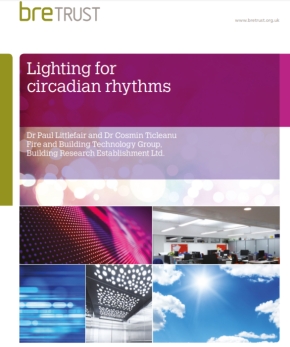Lighting for circadian rhythms
Lighting for circadian rhythms was written by Dr Paul Littlefair and Dr Cosmin Ticleanu and was published by the BRE Trust in October 2019.
People have circadian rhythms linked to the natural light/dark cycle of the day. These control patterns of alertness and sleep as well as other factors such as body temperature and the release of various hormones. Light and dark patterns act as the most important signal to entrain (synchronise) the circadian clock to the solar cycle and cause waking and sleeping to occur at consistent times.
A combination of bright light during the day and darkness at night helps maintain the daily cycle of waking and sleep. However, exposure to artificial light at the wrong times of day can have an adverse effect on circadian rhythms. Light at night time can alter the body clock, suppressing melatonin production and keeping people awake at night, and making them more sleepy during the day.
Circadian lighting varies in colour and intensity during the day. The aim is to improve alertness during working hours using bright light, but to switch to lower brightness, warmer coloured light before it is time to relax.
This report presents the results of an experiment to assess circadian lighting and provides guidance for building owners and occupiers, lighting designers, lighting manufacturers and installers.
Its contents are:
- Abstract.
- Introduction.
- Colour of light.
- Dynamic lighting: previous studies.
- Existing recommendations.
- An experiment to assess variable lighting.
- Results.
- Discussion.
- Conclusions and recommendations.
- Acknowledgements.
- References.
[edit] Related articles on Designing Buildings
- 7 ways better lighting can improve your health.
- BRE articles.
- BRE Expert Collection 6 Daylight and shading.
- BRE Trust.
- BREEAM External lighting.
- BREEAM Internal and external lighting.
- BREEAM Reduction of night time light pollution.
- BREEAM Visual comfort Daylighting.
- Building Research Establishment.
- CIBSE Case Study Hepworth Gallery Lighting.
- Circadian rhythms.
- Colour Rendering Index CRI.
- Daylight benefits in healthcare buildings.
- Health and wellbeing impacts of natural and artificial lighting.
- Human-centric lighting.
- Lighting and health FB 74.
- Lighting and health infographic.
- Lighting.
- Light Pollution - Human Health Impacts from LEDs.
- Types of lighting.
- Use of lighting to improve health and wellbeing.
Featured articles and news
The UK's Modern Industrial Strategy: A 10 year plan
Previous consultation criticism, current key elements and general support with some persisting reservations.
Building Safety Regulator reforms
New roles, new staff and a new fast track service pave the way for a single construction regulator.
Architectural Technologist CPDs and Communications
CIAT CPD… and how you can do it!
Cooling centres and cool spaces
Managing extreme heat in cities by directing the public to places for heat stress relief and water sources.
Winter gardens: A brief history and warm variations
Extending the season with glass in different forms and terms.
Restoring Great Yarmouth's Winter Gardens
Transforming one of the least sustainable constructions imaginable.
Construction Skills Mission Board launch sector drive
Newly formed government and industry collaboration set strategy for recruiting an additional 100,000 construction workers a year.
New Architects Code comes into effect in September 2025
ARB Architects Code of Conduct and Practice available with ongoing consultation regarding guidance.
Welsh Skills Body (Medr) launches ambitious plan
The new skills body brings together funding and regulation of tertiary education and research for the devolved nation.
Paul Gandy FCIOB announced as next CIOB President
Former Tilbury Douglas CEO takes helm.
UK Infrastructure: A 10 Year Strategy. In brief with reactions
With the National Infrastructure and Service Transformation Authority (NISTA).
Ebenezer Howard: inventor of the garden city. Book review.
The Grenfell Tower fire, eight years on
A time to pause and reflect as Dubai tower block fire reported just before anniversary.
Airtightness Topic Guide BSRIA TG 27/2025
Explaining the basics of airtightness, what it is, why it's important, when it's required and how it's carried out.
Construction contract awards hit lowest point of 2025
Plummeting for second consecutive month, intensifying concerns for housing and infrastructure goals.
Understanding Mental Health in the Built Environment 2025
Examining the state of mental health in construction, shedding light on levels of stress, anxiety and depression.























